Hi everyone,
I hope you enjoyed last week’s issue on Kingscrowd – only of the only startups doing due diligence on other startups.
Today we’re diving into Cityfunds — a set of unique city index funds from Nada.
Do you ever wish you could go long on a city’s entire real estate market?
Say you’re bullish on the future of Austin, Miami, or Atlanta. You want exposure to those markets, but don’t have the cash to buy dozens of properties. How would you invest in them?
Nada is the first-ever company that lets you buy into major US real estate hotspots through their index-like real estate funds, for as low as $100.
It’s a cool model. They’re basically fractionalizing shares of cities.
Let’s see what it’s all about
Table of Contents
Summary
- Type: Single-family homes (90% owner-occupied, 10% rentals)
- Accreditation: Anyone can invest. Non-accredited investors are welcome
- Geography: US investors only (for now)
- Minimum investment: $100
- Investment horizon: 5-7 years (but a secondary market for trading shares anytime is coming soon)
- Link: http://www.nada.co/altsco
Housing markets are sort of “stuck”
By now, most people know what’s happening in residential real estate.
Around the world, interest rates are still rising, while property prices are falling. Rental yields are rising (great for landlords, bad for renters) and nobody wants to move.
The entire market feels like a stalemate, with no end in sight. Which is too bad — because diversification is always a good idea, especially when prices are depressed like they are today.
But for many investors, this goal is out of reach. Mortgage payments have rocketed up, supply is down, and the barrier to real estate ownership may actually be the highest it’s ever been.
Sure, there are REITs. But REITs tend to struggle during periods of rising interest rates, and often don’t have the same localized growth potential as a private fund.
This is where Nada comes in.
What is Nada?
Nada is a Dallas-based startup with a new way to own high-growth city real estate.
Nada’s flagship product is its Cityfunds, which lets you invest in diverse portfolios of residential real estate. The funds are centered around some of America’s fastest-growing cities, including Dallas, Austin, Miami, and Tampa.
It’s all done through their app, which is really clean. To download, tap here from your phone, or scan the QR code below.

Who’s the team behind Cityfunds?
Nada is led by CEO John Green, who is also a managing partner of the company’s Cityfunds.
Nada is a current sponsor of Alts, and over the past few weeks we’ve gotten to know John and his team really well. Horacio recently sat down with John for a podcast where they discussed:
- How Nada decides which cities to invest in
- The types of homes that make up Cityfunds
- Providing home equity to owners through Homeshares
- How they underwrite risk
- How the 10-year options contract works through Homeshares
John actually spent most of his 20s as a punk rocker (🤘) but in the 2000s he switched careers to become a mortgage risk and strategy leader at Pacific Union Financial, which was acquired by Mr Cooper (that’s a company, not a guy named “Mister Cooper”)

He soon met co-founder Mauricia Delgado, who spent years working as the CEO of Tricolor Auto Group. Together, they recognized the real estate industry had overwhelming inaccessibility (you think?) and realized they could make a difference.

What are Cityfunds?
Think of Cityfunds like a index fund. They’re an SEC-qualified basket of assets that aim to replicate a city’s residential real estate market.
Interestingly, Cityfunds are actually a joint venture between Nada and Compound Asset Management (an investment manager from New York). Nada also teamed up with Republic to crowdfund their product launch.
The first Cityfunds were released on Republic in August 2021, and blew past their crowdfunding goals. In late 2022, they moved everything over to the Nada app.
Each fund comprises a different number of properties.
- The two Texan Cityfunds have the most exposure. Austin holds 26 properties, while Dallas has 23.
- Meanwhile, the Florida portfolios are still growing, with Miami at 12 properties and Tampa (the newest fund) just 4.
I do question whether 25-30 properties are enough to be considered a true “index” of a city. But Cityfunds are evergreen. Nada is constantly looking to add properties to their portfolios.

Structured like ETFs
Nada designed its portfolios to work more like a passive ETF than an actively managed fund. Each portfolio is like a market index for the city it tracks.
To put it another way, the fund’s performance aims to be bound solely by market movements, rather than the skills of an active investment manager.
On some level, this is a bit of a cop-out. It avoids the responsibility of choosing wisely; of buying the right properties at the right price.
On the other hand, the benefits are obvious – much lower fees and less reliance on someone else’s decision-making.
You pick the city, Nada lets each city’s real estate performance speak for itself. That’s all there is to it.

Investment philosophy
Nada has a two-pronged approach to property acquisition: Homeshares Fractional Acquisition, and Buy and Rent.
The two strategies are not created equal. In fact, Nada employs a 10:1 ratio. For every ten acquisitions focused on building equity, they buy one for rental income. So this is mostly an equity play, with a very small income stream from rental yields.
Buy and Rent (10% of portfolio)
The strategy here is simple. Nada buys up single-family homes and rents them out.
The team employs a “boots-on-the-ground” network of property agents specializing in acquiring homes in emerging markets. The target yield here is around 8-12% per annum.
Homeshares Fractional Investment (90% of portfolio)
But Nada has another way of sourcing properties, and it’s really interesting. The team allows existing homeowners to swap their equity for cash.
That’s right — homeowners can use the cash for anything they’d like: paying off debt, investing in another property, or buying this street-legal Batmobile. It’s sort of like a reverse-mortgage, except not just for old people. They call this program Homeshares.
The process is simple. Homeowners fill out a form to apply, an Nada equity specialist schedules an inspection. If they approve the house, they convert equity into cash.
To me, this is one of the most interesting things about Nada.
For years I’ve been wondering why reverse mortgages aren’t more popular (or why they got such a bad reputation to begin with). Meanwhile, Nada is over here making fractional investments in owner-occupied homes as part of their acquisition strategy.
They get to be co-investors in each property without ever having to step foot inside. And the homeowners get an easy way to turn their illiquid asset into cash. What’s not to love? Win-win! (In fact, some homeowners have used the money they received from their Homeshares equity to invest in Nada’s Cityfunds!)
Returns
With the exception of Dallas, the median home price in each of the four target cities have all doubled in value over the past 10 years:
- Tampa went from $155k to $389k (↑ 251%)
- Miami: $225k to $525k (↑ 233%)
- Austin: $223k to $528k (↑ 236%)
- Dallas $186k to $331k (↑ 177%)

Nada’s Cityfunds currently have $4.2m in AUM , and target an internal rate of return (IRR) of 12-16%. The target hold duration is approximately 5-7 years.
The Cityfunds have only been around since August 2021, and in that time have averaged an appreciation rate of 12%. Austin has been the top performer, returning 14.4% as of January 2023.
Earnings from rental yield and equity appreciation are distributed quarterly as dividends (much like a REIT). The remaining funds are reinvested into new properties, improving each portfolio’s net asset value (and the price of their shares — more on this in a sec).
Who can invest in a Cityfund?
Each of Nada’s Cityfunds are Regulation A offerings.
Like all Reg A offerings, both accredited and non-accredited investors can invest, but the biggest restriction is location. Only US investors can get involved for now. (Though this could change in the future.
Mobile app
The app is clean and well-designed. It gives you the info need (including updated NAVs) without any clutter.

You can find everything you need easily — whether making a new account or tracking the value of your investments.
One nice feature of the app is recurring investments. You can set aside $100+ of your weekly pay and add to your Cityfunds holdings on autopilot.
Secondary market
Liquidity is a major sticking point for real estate investors. Waiting 10+ years for the property to appreciate sufficiently, and selling a house can take months and be a massive time & money suck.=
Fractional platforms can solve this problem. But most of the ones we’ve seen lack a secondary market for selling, meaning you must hang onto your shares until the portfolio manager sells the assets.
However, Nada is partnering with North Capital (a well-respected company) to create a secondary marketplace where Cityfund investors can trade their shares at any time.
The secondary marketplace is set to launch in Q3. Share prices will internally adjust based on the Cityfund’s NAV (Net Asset Value), which is recalculated monthly.
(Note: The fact that Nada updates the share prices monthly presents an interesting arbitrage opportunity for investors. For example, you could use public data to find out that the Austin Cityfund’s NAV is set to increase at month’s end. But if you buy in before Nada adjusts prices, theoretically you’d gain exposure to the portfolio at its original value.)
Fees
Nada’s passive management style means they have a very simple fee structure.
This isn’t like a “2 and 20” hedge fund. Their annual management fee is 1.5% (a little above average, as competitors like Fundrise and global REITs typically charge around 1%) and the team charges an acquisition fee of 1% per purchase.
But that’s it. There are no incentive or performance fees. There’s no carry.
Simple, just like an ETF.
How do Cityfunds stack up?
Liquidity
Okay. But soon to be excellent
Liquidity is usually the biggest issue facing real estate investors. Cityfunds have a secondary marketplace in the works that will let you trade Cityfunds as shares.
It’s not ready yet, but when it is, the liquidity offered will rival what’s available through real estate tokenization.
Accessibility
Good
Getting involved in a difficult asset class like real estate for just a hundred bucks is fantastic. Both accredited and non-accredited investors are welcome too. The big issue here is location — investors from outside the US can’t yet buy Cityfunds.
Returns potential
Solid
Real estate is in a tough spot now, but is obviously a terrific performer over the long term. Nada’s Cityfunds target growth markets that have seen 2x+ returns since 2013.
Each fund targets an IRR of 12-16%, which seems reasonable over the next 7+ years (but it depends on Nada’s cost basis).
The downside here is there’s no active management. You’re basically just riding the real estate wave of each city. (Which isn’t necessarily a bad thing, just worth noting).
Community
Active and supportive
Nada has a tight community of investors. Their 2022 seed round saw $8.1m in funding on Republic. There are thousands of active users on the Nada finance app and the team’s initial Austin offering sold out within a few months.
Fees
Pretty good for a passive fund
The 1.5% management fee is a little higher than some of Cityfunds’ competitors – not to mention other real estate ETFs. However, it is by no means a dealbreaker considering the uniqueness Cityfunds offers.
Competition
A few others around
There are dozens of fractional real estate investing platforms. Cityfunds are also a bit similar to REITs, and real estate tokenization companies (think RealT and HoneyBricks) offer more liquidity.
That said, I think Nada’s offerings are set apart by a few key things. The way they go about sourcing equity in properties is truly unique for this kind of fund.
Most of Cityfund’s competitors don’t provide index-like exposure to one city — you typically invest in a single property at a time (which is riskier).
Usability
Simple
I’m a fan of the Nada mobile app. Stripped-back UX, simple navigation, easy.
It’s worth noting some reviews have complained about compatibility issues with specific mobile devices, but the Nada devs have been quick to fix these bugs.
What’s next for Nada’s Cityfunds?
Nada’s goal is clear — continue building out new Cityfunds.
In the long term, Nada doesn’t intend on limiting themselves to the US. As Nada grows, they want to go international. There’s really not much stopping them from tapping into high-priced global markets like London, Sydney, Dubai, and Hong Kong.
But in the meantime, their next focus is the Mile-High City. A Denver Cityfund will be next cab off the rank for Nada, expected sometime later this year. This will come alongside another massive update, when the team introduces its landmark secondary marketplace.
They plan to grow the family of Cityfunds to over 30 US cities, and according to the SEC circular, they currently have ten cities that are qualified under the SEC: Austin, Dallas, Miami, Houston, Tampa, Denver, Nashville, Phoenix, Las Vegas, and Los Angeles.
Eventually, the plan is to make each Cityfund a publicly listed vehicle — making them even more accessible to retail investors.
Nada’s Cityfunds are still pretty new, but the concept is awesome.
If you want exposure to some of the highest-growth US real estate markets for just $100, Nada is probably a good bet.
Visit Nada.co, and download the app on the iOS App Store or Google Play.
Disclosures
- Nada is a current sponsor of Alts; this was a paid deep dive.
- We do not own any shares of Nada or any Cityfunds through ALTS 1.
- I am considering investing in the Tampa Cityfund myself (I don’t personally love the city of Tampa, but growth is growth!)
This issue is a sponsored deep dive, meaning Alts has been paid to write an independent analysis of Nada. Nada has agreed to offer an unconstrained look at its business & operations. Nada is also a sponsor of Alts, but our research is neutral and unbiased. This should not be considered financial, legal, tax, or investment advice, but rather an independent analysis to help readers make their own investment decisions. All opinions expressed here are ours, and ours alone. We hope you find it informative and fair.












